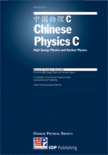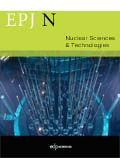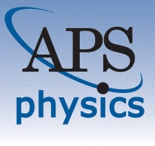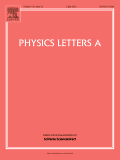
EUROPEAN PHYSICAL JOURNAL A
Scope & Guideline
Empowering Scientific Discovery in Nuclear Physics
Introduction
Aims and Scopes
- Nuclear Structure and Dynamics:
Research focusing on the structure of atomic nuclei, including studies of shell effects, clustering phenomena, and shape coexistence in isotopes. This area explores how nuclear configurations influence stability and decay processes. - Nuclear Reactions and Fission:
Investigations into nuclear reactions, including fusion and fission processes, as well as the dynamics and mechanisms involved in these reactions. This includes cross-section measurements and theoretical modeling of reaction pathways. - Astrophysical Applications:
Studies that relate nuclear physics to astrophysical phenomena, such as nucleosynthesis processes in stars, neutron star properties, and the implications of nuclear reactions in cosmic events. - Quantum Many-Body Physics:
Research employing quantum mechanics to understand many-body systems, focusing on phenomena such as superfluidity, collective excitations, and the role of correlations in nuclear matter. - Experimental Techniques and Instrumentation:
Development and application of advanced experimental techniques, including novel detectors and data analysis methods, to probe nuclear properties and reactions with high precision. - Computational Methods in Nuclear Physics:
Utilization of computational techniques, including Monte Carlo simulations and effective field theories, to model nuclear interactions and predict outcomes of nuclear reactions.
Trending and Emerging
- Quantum Computing Applications:
There is a growing interest in utilizing quantum computing for solving complex problems in nuclear physics, such as simulating many-body systems and optimizing experimental designs. - Interdisciplinary Research:
Research that bridges nuclear physics with other fields, such as astrophysics, materials science, and quantum information, is increasingly prominent, reflecting a trend towards collaborative approaches. - Neutron Star Physics:
The study of neutron stars and their properties is gaining momentum, particularly in the context of gravitational wave detections and the implications for nuclear matter equations of state. - Advanced Detector Technologies:
There is an emerging focus on developing and applying novel detection technologies and data analysis techniques to improve the precision of nuclear measurements and enhance experimental capabilities. - High-Energy Nuclear Collisions:
Research on high-energy nuclear collisions, particularly in the context of heavy-ion physics and the exploration of QCD phase transitions, is becoming increasingly prominent as experimental facilities evolve.
Declining or Waning
- Traditional Nuclear Models:
Research based on older, less sophisticated nuclear models has been declining as more advanced computational methods and models (such as ab initio approaches) become more prevalent. - Static Nuclear Properties:
Studies focusing on static properties of nuclei, such as ground state energies without considering dynamic aspects, have seen reduced emphasis, as researchers increasingly investigate dynamic processes and excitations. - Low-Energy Neutron Capture Studies:
Interest in low-energy neutron capture reactions has waned as the field shifts towards exploring higher energy regimes and more complex reaction mechanisms involving multiple nucleons. - Isolated Nucleus Studies:
Research focused solely on isolated nuclei without considering interactions with external fields or environments is becoming less common, as interdisciplinary approaches are favored.
Similar Journals

ATOMIC DATA AND NUCLEAR DATA TABLES
Bridging theory and application in atomic and nuclear research.ATOMIC DATA AND NUCLEAR DATA TABLES, published by Academic Press Inc Elsevier Science, is a leading journal in the fields of atomic and molecular physics, as well as nuclear and high energy physics. With an ISSN of 0092-640X and an E-ISSN of 1090-2090, this esteemed journal has been providing comprehensive data tables and significant research insights since its establishment in 1969. Spanning until 2024, it continues to serve as an invaluable resource for researchers and professionals aiming to deepen their understanding of atomic interactions and nuclear processes. Holding a commendable Q2 ranking in both relevant categories, it is recognized for its impact, reflected in Scopus rankings, where it ranks 25th out of 87 in Nuclear and High Energy Physics, and 87th out of 224 in Atomic and Molecular Physics. While it does not offer open access, the journal remains a crucial repository for high-quality data essential for scientific endeavors and advancements in these complex fields.

Journal of Condensed Matter Nuclear Science
Bridging Disciplines for a Sustainable Nuclear Future.The Journal of Condensed Matter Nuclear Science, published by the International Society for Condensed Matter Nuclear Science in the United Kingdom, serves as a pivotal platform for researchers exploring the intersections of condensed matter physics and nuclear science. With an ISSN of 2227-3123, this journal has been actively contributing to the academic discourse from its inception in 2016 through its latest volume in 2022. Although classified in Q4 quartiles across various categories, including Atomic and Molecular Physics, Condensed Matter Physics, and Nuclear Energy and Engineering, the journal provides a unique lens on innovative approaches and perspectives that could significantly impact future research directions. This open-access journal appeals to an audience keen on investigating the theoretical and experimental aspects of condensed matter nuclear science, fostering a collaborative environment for scientists, engineers, and students alike. By advancing discussions in this niche field, it aims to attract attention and inspire groundbreaking discoveries that underpin the evolving landscape of nuclear energy and applications.

Moscow University Physics Bulletin
Your Gateway to Cutting-Edge Physics DevelopmentsMoscow University Physics Bulletin is a distinguished journal published by PLEIADES PUBLISHING INC, focusing on a broad spectrum of topics within the field of physics and astronomy. Since its inception, the journal has championed the dissemination of innovative research and advancements, making significant contributions to the academic community. Although currently categorized in the Q4 quartile and ranked #208/243 in the general physics and astronomy field by Scopus, it provides a valuable platform for emerging ideas and discussions in the sector. The journal's publication span, encompassing crucial years from 1975 to 1977, 1982 to 1989, and 2009 to 2024, showcases its resilience and commitment to advancing knowledge. While the journal follows a traditional access model, its content remains pivotal for researchers, professionals, and students aiming to stay abreast of the latest developments in physics. With contributions reflecting both theoretical advancements and practical applications, Moscow University Physics Bulletin is an essential resource for anyone looking to deepen their understanding of contemporary physics.

Chinese Physics C
Championing Open Access to Cutting-Edge Physics InsightsChinese Physics C is a premier, peer-reviewed journal published by IOP Publishing Ltd, dedicated to advancing knowledge in the fields of Astronomy and Astrophysics, Instrumentation, and Nuclear and High Energy Physics. With an impressive impact factor reflecting its standing in the Q1 quartile across multiple categories, this journal serves as a vital resource for researchers, professionals, and students seeking to engage with cutting-edge developments and experimental findings. Since its inception in 2008, Chinese Physics C has fostered significant collaborations and discussions within the global physics community, enabling easy access to high-quality research through its open access options. Operating from the United Kingdom with a commitment to excellence, this journal not only showcases high-impact papers but also encourages innovative methodologies and interdisciplinary approaches, solidifying its role as an essential platform for dissemination and dialogue in the rapidly evolving landscape of physics.

EPJ Nuclear Sciences & Technologies
Advancing the Frontiers of Nuclear InnovationEPJ Nuclear Sciences & Technologies is a prominent Open Access journal published by EDP Sciences S A, focusing on the vital fields of Nuclear and High Energy Physics, Nuclear Energy and Engineering, and Energy Engineering and Power Technology. Launched in 2015, this journal provides a platform for researchers, students, and professionals to disseminate cutting-edge research and innovations that address the challenges and opportunities in nuclear sciences, a field of critical importance in today’s energy landscape. With an ISSN of 2491-9292 and an evolving impact reflected in its 2023 Q3 quartile rankings across several relevant categories, EPJ Nuclear Sciences & Technologies is committed to promoting high-quality, peer-reviewed research accessible to a global audience. Its dedicated focus on enhancing knowledge transfer and international collaboration makes it an essential resource for anyone engaged in nuclear sciences and technologies.

PHYSICAL REVIEW D
Advancing the Frontiers of Nuclear and High Energy PhysicsPHYSICAL REVIEW D, published by the American Physical Society, is a premier journal dedicated to the rapid dissemination of significant research findings in the fields of Nuclear and High Energy Physics as well as Physics and Astronomy. With an impressive Impact Factor and a prestigious Q1 ranking in 2023, it stands as one of the leading journals in its domain, with a Scopus ranking of #6 out of 87 in its category, placing it in the 93rd percentile. The journal welcomes rigorous theoretical and experimental studies that advance understandings in particle physics, cosmology, and quantum field theory. Although it does not provide open access, researchers gain a significant platform to reach a global audience and contribute to the ongoing discourse within the scientific community. Published regularly since its convergence starting in 1989, it remains essential for both emerging and established scholars looking to stay at the forefront of high-energy and nuclear physics research.

PHYSICAL REVIEW C
Elevating Knowledge in High-Energy PhysicsPHYSICAL REVIEW C is an esteemed journal published by the American Physical Society, dedicated to advancing knowledge in the fields of nuclear and high-energy physics. With a proud ISSN of 2469-9985 and an E-ISSN of 2469-9993, it has established itself as a leading journal, currently ranked in the Q1 category for its field in 2023, positioning itself in the top tier of scholarly publications. Based in the heart of the United States, at One Physics Ellipse, College Park, MD, PHYSICAL REVIEW C is known for its rigorous peer-review process and is a vital platform for researchers to share their pioneering findings. As part of a prestigious lineup backed by an impressive impact factor, this journal garners significant attention, reflected in its Scopus ranking as #18 out of 87 in the Nuclear and High Energy Physics category, placing it within the 79th percentile. While it currently does not offer open access options, it remains an essential resource for professionals and students seeking to deepen their understanding of nuclear interactions, reaction dynamics, and the fundamental principles governing subatomic particles. The convergence of innovative research from 2016 to 2024 makes it a timely reservoir for groundbreaking studies, thus reinforcing its importance in the scientific community.

PHYSICS LETTERS A
Catalyzing Academic Exchange in PhysicsPhysics Letters A is a renowned scientific journal published by Elsevier, dedicated to the field of physics and astronomy. Established in 1963, it has continuously evolved, offering a platform for the swift dissemination of significant research findings in various branches of physics. As of 2023, it holds a commendable Q2 ranking in the category of Physics and Astronomy (miscellaneous) and ranks 69th out of 243 journals in the same domain according to Scopus, positioning itself in the 71st percentile of academic impact. With its comprehensive scope, Physics Letters A provides a vital resource for researchers, professionals, and students, facilitating academic discourse and advancing knowledge across the field. Although it does not currently offer Open Access options, its rigorous peer-review process ensures high-quality content. It is centrally located in Amsterdam, Netherlands, and continues to be an essential outlet for innovative contributions to the physics community through the year 2024 and beyond.

INTERNATIONAL JOURNAL OF MODERN PHYSICS A
Fostering collaboration in the realms of astrophysics and high energy physics.INTERNATIONAL JOURNAL OF MODERN PHYSICS A, published by WORLD SCIENTIFIC PUBL CO PTE LTD, stands as a pivotal platform in advancing the frontiers of research within the fields of Astronomy and Astrophysics, Atomic and Molecular Physics, and Nuclear and High Energy Physics. Established in 1989, this journal has systematically contributed to the scientific community, with a demonstrated impact as indicated by its Q2 category rankings across these critical disciplines in 2023. Researchers and professionals are encouraged to engage with its rigorous peer-reviewed content, fostering a deeper understanding of modern physics theories and experimental breakthroughs. Although the journal operates under a conventional access model, it remains a vital resource for those seeking to disseminate their findings and stay abreast of cutting-edge developments. With an emphasis on quality and breadth of research, the journal continues to attract submissions from leading physicists and scholars, enhancing its reputation as a key academic resource.

Annual Review of Nuclear and Particle Science
Advancing Knowledge in Nuclear and Particle ScienceAnnual Review of Nuclear and Particle Science is a prestigious journal published by Annual Reviews, focused on the fields of nuclear and high-energy physics. With an impressive impact factor that reflects its authority and influence—ranked Q1 in its category and holding a commendable Scopus rank of #2 out of 87, placing it in the 98th percentile—the journal serves as an essential resource for researchers, professionals, and advanced students alike. Covering pivotal developments and comprehensive reviews in nuclear and particle physics since its inception in 1978, this journal offers unparalleled insights into cutting-edge research and theoretical advancements. While it is not open access, the value of its scholarly content is evidenced by its rigorous peer-review process and its role in shaping contemporary discourse within the scientific community. With contributions from leading experts and a commitment to disseminating foundational and emerging theories, the Annual Review of Nuclear and Particle Science is indispensable for those seeking a deep understanding of the complexities in these dynamic fields.